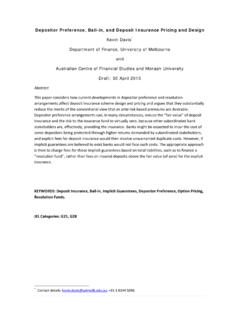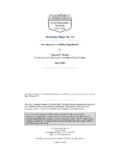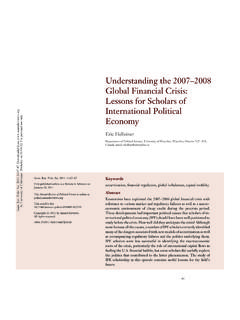Transcription of Competition and Financial Regulation Kevin Davis ...
1 Competition and Financial Regulation * Kevin Davis , university of melbourne , australian Centre for Financial Studies and Monash university ** November 14, 2014 1. Introduction This paper focuses on the interactions between Financial Regulation and Competition in Financial markets. Those interactions run deep, and involve consideration of both micro- and macro-prudential Regulation , consumer protection, and access/network Regulation . Three fundamental issues permeate the analysis. First, Competition is associated with failure and exit of suppliers from the industry (as per Schumpeter s well known process of creative destruction metaphor) which has implications for Financial stability Regulation if exit is disorderly. Second, digital technology is rapidly changing the competitive landscape of Financial markets, raising issues about the appropriate design of Financial Regulation and its perimeter.
2 Third, information deficiencies and behavioural biases of consumers of Financial services and products, and consequent responses of Financial firms to those, are important determinants of the nature of Competition in Financial markets. Competition (or contestability) in Financial markets is important for a number of reasons. One is its role in the efficient allocation of Financial resources channelling available funds from savers to those best able to productively use A second is its importance in putting downward pressure on the operational costs of performing that role (and other functions) of the Financial sector, including introduction of new cost-saving or quality enhancing technological innovations. A third is in providing opportunities for consumer choice between suppliers of Financial products and services, whose decisions can impose demand side pressures for improved operational efficiency and product design.
3 These roles remain important even though recent academic research on Financial institutions and markets cast doubt on whether Financial markets even come close to behaving like the hypothetical perfect, self-stabilizing, markets underpinning textbook demonstrations of the optimality of free competitive Financial markets are prone to instability, sustained * This paper is based on a talk given to the melbourne university Victoria university Economic Policy Forum on 25 September 2014. While it addresses issues considered in the Interim Report of the australian Financial System Inquiry, comments made should not be interpreted as reflecting views of the Inquiry, of which I am a member. ** Contact details: 1 For example, Competition will encourage lenders to better identify differences in borrower risk, and set loan interest rates accordingly such that borrowers with higher risk projects will require higher expected returns to make those projects worthwhile.
4 Lenders unable to differentiate between borrowers of different risk will face the problem of adverse selection setting loan interest rates to reflect average risk, but attracting higher risk borrowers with obvious consequences for profitability and ultimate survival. 2 A recent survey of some of this research is provided by Markus ,Thomas and Yuliy Sannikov Macroeconomics with Financial Frictions: A Survey Advances In Economics And Econometrics, Tenth World Congress Of The Econometric Society, Volume 2. New York: Cambridge university Press, 2013. See also Franklin Allen, Ana Babus, Elena Carletti (2009), Financial Crises: Theory and Evidence, Annual Review Page | 1 deviation of Financial prices from fundamental values, and subject to complex network interrelations which mean that shocks can be amplified and transmitted throughout the Some of these features reflect the fact that the standard caveats (to optimality of free markets) of imperfect information, externalities (spillovers), market power and public good characteristics, apply with particular force to Financial markets where intertemporal contracts and incomplete markets are fundamental features.
5 More generally, however, this research emphasises the problems arising from the difficulties in designing and enforcing Financial contracts which involve future commitments in a world of imperfect information and where markets do not exist to enable precise specification of contract outcomes for all possible future contingencies. Leveraged positions, portfolio mismatches and liquidity creation are among the important characteristics of Financial institutions and markets which involve, at their heart, risk-taking, and their relevance for potential instability was brought home clearly in the Global Financial Crisis. 2. Competition and Stability There is a long-standing debate over the compatibility of Competition and stability in Financial Unfettered Competition can lead to excessive risk taking, disruptive failures, and contagion risks, while "franchise value" from market power reduces managerial risk-taking incentives.
6 Prudential Regulation (and supervision) ideally enables Competition within "acceptable" risk limits by regulated institutions (such as by imposing minimum capital and liquidity requirements on banks). However, it can create competitive distortions between types of Financial activities (such as bank intermediation versus capital markets) and between Financial institutions (both regulated and unregulated). One such distortion arises from implicit government guarantees , whether real or perceived, of bank safety most evident in the case of Too Big To Fail (TBTF) institutions. Such implicit guarantees give a competitive advantage in deposit and debt markets and reduce the cost of funding for such institutions, which in turn provides a competitive advantage in lending markets. The competitive advantage is not just against other Financial institutions undertaking the same type of intermediation.
7 It is also relevant to Competition with capital market funding channels (where savers demand a default risk premium to invest directly in bonds issued by companies) because bank borrowing rates then include no (or a reduced) premium for default risk (even though the risk arising from their loans to companies and others may mean that their deposits do involve some default risk). Currently, following the Global Financial Crisis experience, in which implicit guarantees became explicit and entrenched perceptions of their existence, there are a range of measures being taken internationally to reduce perceptions and the value of implicit guarantees. of Financial Economics, December 2009. 3 On Financial networks, see, for example, Andrew G Haldane Rethinking the Financial network 4 See for example, Berger, Allen N.
8 , Leora F. Klapper, and Rima Turk-Ariss. "Bank Competition and Financial stability." Journal of Financial Services Research (2009): 99-118. Page | 2 Although these are driven primarily by the desire to protect taxpayers from the cost of such guarantees, they are also relevant for reducing resulting competitive imbalances. They include higher capital and liquidity requirements (to reduce risk of bank failure) and introduction of bail-in debt requirements to facilitate resolution of troubled institutions without call on tax-payer funds. There are also additional capital requirements for systemically important institutions which, while based on stability grounds, also reduce competitive imbalances from TBTF distortions.
9 But some of the regulatory arrangements themselves arguably induce competitive distortions. Under the Basel Accord, minimum capital requirements are based on risk-weighted assets where the risk-weights reflect (inter alia) credit risk. Large banks are accredited by regulators to use their own internal risk based models for assessing credit risk and incentivised to develop such models by lower capital requirements than for smaller banks (holding similar assets) using the standardised approach prescribed by regulators. This can mean that the proportion of equity capital required in the funding of a loan (in addition to the deposit/debt funding component) can be (for example) twice as large for banks using the standardised approach. Whether this creates a competitive distortion depends on whether a higher capital ratio (lower leverage) affects the weighted average cost of funds for a bank.
10 Most bankers argue that it does assuming that there is no, or little, resulting change in the individual cost of deposit/debt and equity components, such that the shift in weighting to the higher cost component increases the average cost. An opposite, equally extreme perspective, is that both those individual costs will decline sufficiently due to lower risk such that the average cost is In that view, lower costs reflect lower required returns from equity holders who face lower systematic (beta) risk due to lower leverage, and from depositors/debt-holders who face lower default risk. Reality, undoubtedly, lies somewhere between these extremes, but one important consideration is that implicit guarantees (or incomplete understanding of risk involved) mean that investors treat deposits/debt as risk-free independent of leverage, such that its cost does not change.








